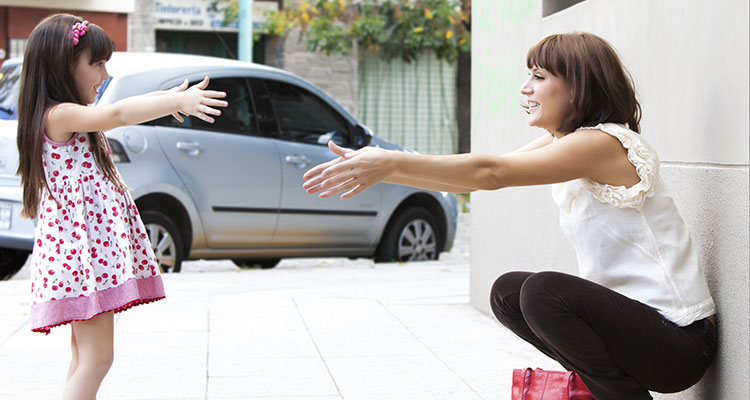Time-out consists of immediately isolating a child in a boring place for a few minutes whenever she misbehaves. Time-out is also called quiet time, thinking time, or cooling-off time. Time-out has the advantage of providing a cooling-off period to allow both child and parent to calm down and regain control of their emotions.

Used repeatedly and correctly, the time-out technique can change almost any childhood behavior. Time-out is the most effective consequence for toddlers and preschoolers who misbehave-much better than threatening, shouting, or spanking. Every parent needs to know how to give time-out.
Time-out is most useful for aggressive, harmful, or disruptive behavior that cannot be ignored. Time- out is unnecessary for most temper tantrums. Time- out is not needed until a child is at least 8 months old and beginning to crawl. Time-out is rarely needed for children younger than 18 months because they usually respond to verbal disapproval. The peak ages for using time-out are 2 to 4 years. During these years children respond to action much better than to words.
Choosing a place for time-out 🔗
Time-out chair 🔗
When a chair is designated for time-out, it gives time-out a destination. The chair should be in a boring location, facing a blank wall or a corner. Don’t allow your child to take anything with her to time-out, such as a toy, pacifier, security blanket, or pet. The child shouldn’t be able to see television or other people from the location. A good chair is a heavy one with side arms: Placed in a corner, such a chair surrounds the child with boundaries, leaves a small space for the legs, and reduces thoughts of escape. Alternatives to chairs are standing in a particular corner, sitting on a particular spot on the floor, or being in a playpen (if the child is not old enough to climb out of it).
Usually the chair is placed in an adjacent hallway or room. Some children less than 2 years old have separation fears and need the time-out chair (or playpen) to be in the same room as the parent. When you are in the same room as your child, carefully avoid making eye contact with the child.
Time-out room 🔗
Children who refuse to stay in a time-out chair need to be sent to a time-out room. Confinement to a room is easier to enforce. The room should be one that is safe for the child and contains no valuables. The child’s bedroom is often the most convenient and safe place for time-out. Although toys are available in the bedroom, the child does not initially play with them because he or she is upset about being excluded from mainstream activities. Forbid turning on the radio, stereo, or video games during time-out in the bedroom. Avoid any room that is dark or scary (such as some basements), contains hot water (bathrooms), or has filing cabinets or bookshelves that could be pulled down on the child.
Time-out away from home 🔗
Time-out can be effectively used in any setting. In a supermarket, younger children can be put back in the grocery cart and older children may need to stand in a comer. In shopping malls, children can take their time-out sitting on a bench or in a restroom. Sometimes a child needs to be taken to the car and made to sit on the floor of the back seat for the required minutes. If the child is outdoors and misbehaves, you can ask her to stand facing a tree.
How to administer time-out 🔗
Deciding the length of time-out 🔗
Time-out should be short enough to allow your child to have many chances to go back to the original situation and learn the acceptable behavior. A good rule of thumb is 1 minute per year of age (with a maximum of 5 minutes). After age 6, most children can be told they are in time-out “until you can behave,” allowing them to choose how long they stay there. If the problem behavior recurs, the next time-out should last the recommended time for their age. Setting a portable kitchen timer for the required number of minutes is helpful. The best type ticks continuously and rings when the time is up. A timer can stop a child from asking the parents when he or she can come out.
Sending your child to time-out 🔗
Older children will usually go to time-out on their own. Younger children often need to be led there by their wrist, or in some cases carried there protesting. If your child doesn’t go to time-out within 5 seconds, take her there. Tell your child what she did wrong in one sentence (such as, “No hitting”). If possible, also clarify the preferred behavior (such as, “Be kind to George”). These brief comments give your child something to think about during the time-out.
Requiring quiet behavior in time-out 🔗
The minimum requirement for time-out completion is that your child does not leave the chair or time- out place until the time-out is over. If your child leaves ahead of time, reset the timer. Some parents do not consider a time-out to be completed unless the child has been quiet for the entire time. However, until 4 years of age, many children are unwilling or unable to stay quiet. Ignore tantrums in time-out, just as you should ignore tantrums outside of time-out. After age 4, quiet time is preferred but not required. You can tell your child, “Time-out is supposed to be for thinking, and to think you’ve got to be quiet. If you yell or fuss, the time will start over.”
Dealing with room damage 🔗
If your child makes a mess in his room (e.g., empties clothing out of drawers or takes the bed apart), she must clean it up before she is released from time-out. Toys that were misused can be packed away. Some damage can be prevented by removing any scissors or crayons from the room before the time-out begins.
Releasing your child from time-out 🔗
To be released, your child must have performed a successful time-out. This means she stayed in time-out for the required number of minutes. Your child can leave time-out when the timer rings. If you don’t have a timer, she can leave when you tell her, “Time-out is over. You can get up now.” Many parents of children over 4 years old require their children to be quiet at the end of time-out. If a child is still noisy when the timer rings, it can be reset for 1 minute.
Back-Up Plans 🔗
The younger child who refuses to stay in time-out 🔗
In general, if a child escapes from time-out (gets up from the chair or spot), you should quickly take the child back to time-out and reset the timer. This approach works for most children. If a child refuses to stay in time-out, the parent should take action rather than arguing or scolding the child. You may temporarily need to hold a strong-willed, 2- or 3- year-old child in time-out. Holding your child in time-out teaches your child that you mean what you say and that she must obey you. Place your child in the time-out chair and hold her by the shoulders from behind. Tell your child that you will stop holding her when she stops trying to escape. Then avoid eye contact and any more talking. Pretend that you don’t mind doing this and are thinking of something else or listening to music. Your child will probably stop trying to escape after a week of this approach.
A last resort for young children who continue to resist sitting in a chair is putting them in the bedroom with a gate blocking the door. Occasionally a parent with carpentry skills can install a half-door. If you cannot devise a barricade, then you can close the door. You can hold the door closed for the 3 to 5 minutes it takes to complete the time-out period. If you don’t want to hold the door, you can put a latch on the door that allows it to be temporarily locked. Most children need their door closed only two or three times.
The older child who refuses to stay in time-out 🔗
An older child can be defined in this context as one who is too strong for the parent to hold in a time-out chair. In general, any child older than 5 years who does not take time-out quickly should be considered a refuser. In such cases the discipline should escalate to a consequence that matters to the child. First, you can make the time-out longer, adding 1 extra minute for each minute of delay. Second, if 5 minutes pass without your child going to time-out, your child can be grounded. “Grounded” is defined as no television, radio, stereo, video games, toys, telephone access, outside play, snacks, or visits with friends. After grounding your child, walk away and no longer talk to her. Your child becomes “un-grounded” only after she takes her regular time-out plus the 5 minutes of penalty time. Until then, her day is very boring. If your child refuses the conditions of grounding, she can be sent to bed 15 minutes earlier for each time she breaks the grounding requirements. The child whose behavior doesn’t improve with this approach usually needs to be evaluated by a mental health professional.
Practicing time-out with your child 🔗
If you have not used time-out before, go over it with your child before you start using it. Tell your child it will replace spanking, yelling, and other forms of discipline. Review the kinds of negative behavior that will lead to placement in time-out. Also review the positive behavior that you would prefer. Then pretend with your child that he has broken one of the rules. Take him through the steps of time-out so he will understand your directions when you send him to time- out in the future. Also teach this technique to your babysitter.
When It Doesn’t Seem To Be Working 🔗
Some parents become discouraged with time-out. Their child repeats misbehavior immediately after release from time-out. Some children refuse to go to time-out or won’t stay there. None of these examples means that time-out should be abandoned. It remains the best discipline technique for 2- to 5-year-old children. If you use time-out repeatedly, consistently, and correctly, your child will eventually improve. The following recommendations may help you fine-tune how you are using time-out.

More affection 🔗
Give your child more physical affection each day. Be sure your child receives two time-ins for every time-out each day. A time-in is a positive, close, brief human interaction. Try to restore the positive side of your relationship with your child. Catch him being good. Try to hold your child for 1 or 2 minutes every 15 minutes when he is not in time-out or misbehaving. Play with your child more. Children who feel neglected or overly criticized don’t want to please their parents.
Change target behavior 🔗
Use time-out every time your child engages in the behavior you are trying to change (target behavior). Use time-out more frequently. For the first 2 or 3 days you may need to use time-outs 20 or more times a day to gain a defiant toddler’s attention. Brief time-outs are harmless and there is no upper limit on how many times you can use them as long as you offset them with positive interactions.
Don’t threaten, use time-out 🔗
Use time-out. Don’t just threaten to use time- out. For aggressive behaviors, give no warnings; just put your child in time-out. Better yet, intercept your child when you see him starting to raise his arm or clench his fist and before he makes others cry. For other behaviors, remind your child of the rule, count to three, and if he doesn’t stop immediately, put him in time-out.
Put your child in time-out earlier 🔗
Put your child in time-out before his behavior worsens. Your child is more likely to accept a time-out calmly if he’s put in early rather than if he’s put in late (and screaming). Also, putting him in early means you will be more in control of your emotions. Try to put your child in time-out before you become angry. If you are still yelling when you put your child in time-out, it will not work.
Don’t delay 🔗
Put your child in time-out quickly. Don’t talk about it first. When your child breaks a rule, have him in time-out within 10 seconds.
Isolation 🔗
Don’t talk to your child during time-out. Don’t answer his questions or complaints. Don’t try to lecture your child.
Ignore tantrums in time-out 🔗
Don’t insist on quietness during time-out because it makes it harder to finish the time-out.
Return to time-outs 🔗
Return your child to time-out if he escapes. Have a back-up plan for further discipline, for example, holding a young child in the time-out chair or grounding an older child.
Consider increasing the length of time-out 🔗
If your child is over 3 years old and needs to be placed in time-out more than 10 times each day, a longer time-out may be needed to get his attention. A preschooler with a strong-willed temperament may temporarily need a time-out that lasts 2 or 3 minutes per year of his age. Children younger than 3 years should receive only brief time-outs (1 minute per year of age) because it is difficult for them to stay in time-out any longer.
Make the time-out place more boring 🔗
If your child doesn’t seem to mind the time-outs, eliminate sources of entertainment. Move the time-out chair to a more boring location. If you use your child’s bedroom, close the blinds or shades. Temporarily remove all toys and games from the bed- room and store them elsewhere.
Keep track of time 🔗
Use a portable timer for keeping track of the time. Your child is more likely to obey a timer than to obey you.
Be kind 🔗
Be kinder in your delivery of time-out. This will help reduce your child’s anger. Say you’re sorry he needs a time-out, but be firm about it. Try to handle your child gently when you take him to time-out.
Praise and forgive 🔗
Praise your child for taking a good time-out. Forgive your child completely when you release him from time-out. Don’t give lectures or ask for an apology. Give your child a clean slate and don’t tell his father or relatives how many time-outs he needed that day.
Don’t punish anger 🔗
Don’t punish your child for the normal expression of anger. If he is saying angry things or looking angry, don’t be too alarmed. Don’t try to control your child too much.
Provide choices 🔗
Give your child more choices about how he takes his time-out. Ask, “Do you want to take a time-out by yourself or do you want me to hold you in your chair? It doesn’t matter to me.” (For older children, the choice can be, “By yourself or do you want to be grounded?”)
Give your child the option of coming out of time-out as soon as he is under control rather than taking the specified number of minutes. Some children feel overly controlled.
Use variety 🔗
Use a variety of consequences for misbehavior. Ignore harmless behaviors. Also use distraction for bad habits. Use logical consequences such as removal of toys, other possessions, or privileges for some misbehavior.
Clarify with your child what you want him to do. Also clarify the house rules. Review this at a time when your child is in a good mood. This will help him be more successful.
Group time-out 🔗
Use time-out with siblings when appropriate. If siblings touch the timer or tease the child in time-out, they should also be placed in time-out. Teach all caretakers to use time-out correctly and consistently.



